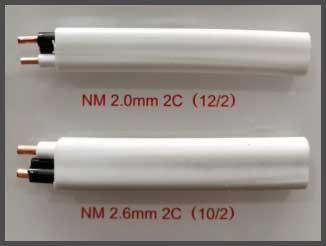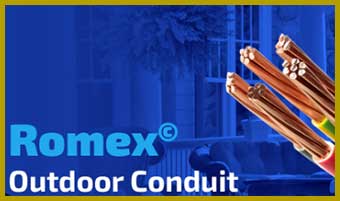When it comes to electrical wiring, understanding your choices is crucial. The last thing you’d want is to be tangled up in a web of confusing terminologies. Enter the showdown: Loomex and Romex.
Both are stalwarts in the electrical wiring industry, and each has its own unique set of benefits and drawbacks. Let’s dive into the intricate world of wires and uncover which might be the best choice for your project.
A Brief Comparison Table
| Feature | Loomex | Romex |
| Origin | Canada | U.S. (Brand Name) |
| Material | PVC Jacket | Thermoplastic Sheath |
| Suitability | Dry and Damp Environments | Not Suitable for Conduit, Mostly Dry |
| Outdoor Use | Limited (not for exposed situations) | Limited (not for fully exposed work) |
| Cost-effectiveness | More economical | Can be pricier |
| Regional Availability | Predominantly Canada | Widely recognized in the U.S. |
Loomex: An Overview
Firstly, there seems to be a bit of confusion surrounding the name. Is it Lumex? Or Loomex? For clarity, it’s Loomex. It’s a term primarily used in Canada to refer to what many other regions call non-metallic sheathed cable (NMSC).
Key Features of Loomex:

- Non-Metallic Sheathed Cable: Loomex, much like Romex, is a type of non-metallic sheathed cable. This means it comes with two or more insulated conductors and often includes a bare ground wire.
- PVC Jacket: The outer sheathing of Loomex is made from polyvinyl chloride (PVC), offering a level of protection against moisture.
- Diverse Use: It’s employed widely in residential, commercial, and some industrial settings.
Pros of Loomex:
- Adaptability: Loomex is versatile and can be used in a range of environments, both wet and dry.
- Safety: Its PVC sheathing offers added protection from the elements.
- Cost-Effective: For those on a budget, Loomex usually comes in as a more economical choice than many alternatives.
Cons of Loomex:
- Not for Exposed Work: Loomex isn’t recommended for exposed outdoor applications.
- Limited to Certain Regions: Its usage and name recognition are largely confined to Canada.
Romex: A Closer Look
Key Features of Romex:
- Trade Name: Firstly, it’s essential to recognize that Romex is a brand name. However, it has become so synonymous with non-metallic sheathed cable in the US that it’s often used interchangeably.
- Non-Metallic Sheathed Cable: Like Loomex, Romex is a type of NMSC, meaning it has multiple insulated conductors and usually a bare ground wire.
- Thermoplastic Sheathing: Romex is enclosed in a thermoplastic sheath that protects against moisture and damage.
Pros of Romex:

- Durability: The thermoplastic sheathing ensures a longer lifespan and protection against common wear and tear.
- Widely Recognized: In the U.S., it’s a household name. When people talk about wiring, Romex is often what they have in mind.
- Easy to Work With: For many electricians and DIY enthusiasts, Romex is easier to manipulate and install.
Cons of Romex:
- Not for Conduit: This is a big one, and we’ll explore more in our FAQs. Romex isn’t designed to be pulled through conduit, mainly due to potential heat buildup.
- Not Always Outdoor-Suitable: Like Loomex, Romex isn’t suitable for all outdoor applications, especially when exposed.
Key Differences Between Loomex and Romex
When selecting electrical wiring for projects, it’s vital to understand the nuances that distinguish one type of wire from another.
Although Loomex and Romex may sound similar and both function as non-metallic sheathed cables, they carry distinct characteristics, applications, and histories. This comprehensive breakdown will illuminate the key differences between Loomex and Romex.
- Origins and Popularity
Loomex
Loomex’s story begins in Canada. It’s predominantly a Canadian term referring to non-metallic sheathed cable. If you were to engage in a discussion about electrical wiring in Canada, Loomex would be a name that pops up frequently.
Romex
Romex, on the other hand, is not just a type of wire. It’s a brand name that has become synonymous with non-metallic sheathed cable in the U.S., almost like how people refer to tissues as “Kleenex.” It’s deeply ingrained in American electrical culture.
- Construction and Material
Loomex
Loomex is housed within a PVC (polyvinyl chloride) jacket. This provides a degree of protection against moisture, making it versatile for both dry and occasionally damp conditions.
Romex
Romex cables are ensconced in a thermoplastic sheath. This sheathing is not just moisture-resistant but also brings an added layer of durability against general wear and tear.
- Suitability and Application
Loomex
Loomex’s versatility makes it a prime choice for multiple environments, be it dry or damp. However, for outdoor applications, especially where the wire might be exposed, Loomex might not be the best fit.
Romex
Romex, while robust and durable, isn’t recommended for all outdoor applications either. Especially when it might be exposed to the elements. Additionally, one of its significant limitations is its unsuitability for conduit usage.
- Pricing and Cost-effectiveness
Loomex
Generally, Loomex tends to be more economical. It offers a good balance of durability and functionality without breaking the bank. This makes it an attractive choice for those who want reliability without splurging excessively.
Romex
While Romex is also cost-effective, it can sometimes lean towards the pricier side, especially when compared directly to Loomex. Its brand recognition and the durable thermoplastic sheathing can add to its cost.
- Regional Availability
Loomex
Loomex is predominantly available and recognized in Canada. If you’re in a different region, especially outside North America, you might find it challenging to source Loomex or encounter professionals who are familiar with the term.
Romex
Romex boasts of broad availability and recognition across the U.S. Venturing outside, while the brand might not be as prominent, the term is often understood due to its ubiquitous association with non-metallic sheathed cable.
Frequently Asked Questions (FAQ)
It’s Romex and Loomex. Romex is the brand-associated term for NMSC in the U.S., while Loomex is the term often used in Canada.
Loomex is essentially Canada’s answer to Romex. It’s a type of non-metallic sheathed cable used for electrical wiring, featuring multiple insulated conductors and often a bare ground wire, all encased in a protective PVC jacket.
Romex isn’t designed for conduit use. When Romex is inside a conduit, it can lead to overheating because the sheathing doesn’t dissipate heat as effectively as other wiring methods. The National Electric Code (NEC) outlines this, prioritizing safety.
If Romex isn’t suitable for your project, there are alternatives:
THHN Wire: Designed for conduit use and comes with individual conductors.
Metal-Clad (MC) Cable: Features a metal outer sheathing, making it suitable for both exposed and concealed work.
UF-B Cable: Underground Feeder Cable, perfect for outdoor, direct burial applications.
Wrapping Up
Both Loomex and Romex have their unique spaces in the electrical world. Whether you lean toward the Canadian stalwart Loomex or the U.S. favorite Romex, it’s all about understanding their strengths and limitations in context.
Stay electrified, and make sure you’re always wired for success!
